R.J. Stowell's Blog: rjsomeone, page 42
August 26, 2019
The Catalyst of Woodstock and Miles From Nowhere
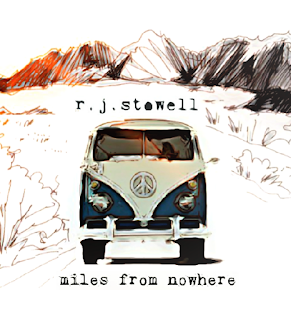 Miles From Nowhereis a novel about a young man whose teen years were often spent in the hospital. Miles at 17 finally gets the kidney transplant he needs, and at 19, after the death of this father, Miles heads out on a 3000-mile trek from California to Woodstock; like everything, it's about the journey.
Miles From Nowhereis a novel about a young man whose teen years were often spent in the hospital. Miles at 17 finally gets the kidney transplant he needs, and at 19, after the death of this father, Miles heads out on a 3000-mile trek from California to Woodstock; like everything, it's about the journey. Woodstock and this the fascinating country of ours do more than just provide a backdrop to Miles' story, they become characters within the journey. Of course, my research for the novel, which I wrote over the better part of the past three years, includes everything from Woodstock to Kidney Transplants to the American subculture, weaving a story to connect them all.
They say if you were at Woodstock, you don't remember it. Miles remembers. But let's put it into perspective, let's go back to the beginning, not of Miles' story, but the story of Woodstock itself.
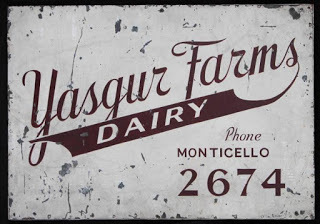 In Early 1969, 50 years ago, music entrepreneurs Joel Roseman and John Roberts were the financial backing for what would become Mediasound, a state of the art recording studio in Manhattan that would over time produce artists like Stevie Wonder, Blondie, and Talking Heads. The pair, still in their mid-20s, printed an ad in the New York Times that read, "Young men with unlimited capital looking for interesting, legitimate investment opportunities and business propositions," In February, Michael Lang, considered the impetus behind Woodstock, and his partner, Arthur Kornfeld, approached Roberts and Roseman about funding a studio in the Catskill Mountains near Woodstock New York, the home of Bob Dylan and The Band, Paul Butterfield and Donald Fagan. Instead, Roberts and Roseman proposed a concert festival featuring those same artists. And with that, Woodstock Ventures was born. Told you Bob and The Band were the catalysts of Woodstock).
In Early 1969, 50 years ago, music entrepreneurs Joel Roseman and John Roberts were the financial backing for what would become Mediasound, a state of the art recording studio in Manhattan that would over time produce artists like Stevie Wonder, Blondie, and Talking Heads. The pair, still in their mid-20s, printed an ad in the New York Times that read, "Young men with unlimited capital looking for interesting, legitimate investment opportunities and business propositions," In February, Michael Lang, considered the impetus behind Woodstock, and his partner, Arthur Kornfeld, approached Roberts and Roseman about funding a studio in the Catskill Mountains near Woodstock New York, the home of Bob Dylan and The Band, Paul Butterfield and Donald Fagan. Instead, Roberts and Roseman proposed a concert festival featuring those same artists. And with that, Woodstock Ventures was born. Told you Bob and The Band were the catalysts of Woodstock). At this point in time, no one knew what Woodstock would become, indeed, Lang and Kornfeld couldn’t find anyone who wanted to participate until April 1969 when Creedence Clearwater signed on agreeing to play for $10,000, roughly the equivalent of a 100 grand today. CCR’s signing led to the interest of a myriad of others from unknowns like Joe Cocker to Jimi Hendrix and The Who. Interestingly, the event that would host the half-million
At this point in time, no one knew what Woodstock would become, indeed, Lang and Kornfeld couldn’t find anyone who wanted to participate until April 1969 when Creedence Clearwater signed on agreeing to play for $10,000, roughly the equivalent of a 100 grand today. CCR’s signing led to the interest of a myriad of others from unknowns like Joe Cocker to Jimi Hendrix and The Who. Interestingly, the event that would host the half-millionstrong was a muddy mess from beginning to end, the concert didn’t even take place in Woodstock but some 50 miles away at Yasgur‘s Dairy Farm in Bethel Woods, expected crowd? Just 50,000. First order of business? The Fab Four of Woodstock printed tickets for what they called The Aquarian Festival, Three Days of Peace and Music. One day, $7, just twice what a movie cost at the time; two days $13, all three days, $18. Split four ways, Lang and Kornfeld figured they’d clear enough to build their recording studio.
But things slid downhill from there. Downhill in the mud. Fast forward to July 2, 1969, just six weeks prior to the festival, when the town of Wallkill, just outside the Woodstock city limits, passed an ordinance prohibiting the concert. It wasn't till mid-July that Max Yasgur offered up his 600-acre dairy farm fifty mikes down the road. Now on a timeline of less than a month, there was barely time to build the stage, the outbuildings, the ticket booths or the perimeter fence. The fence wasn't completed and the ticket booths were never even started. Woodstock was now a free concert.
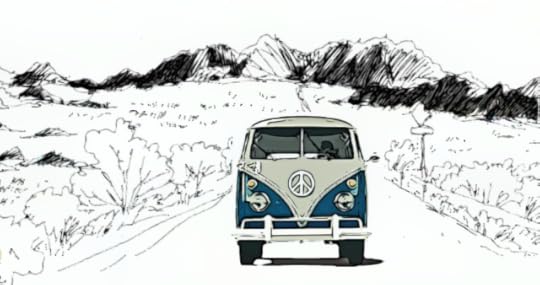 And here's a bit of a spoiler for the novel; Miles doesn't make it to the three-day concert until day four! Rain, lightning, overcrowding, a lack of facilities turned the three days of peace and love into four days of mud. Miles would make it for Hendrix, though, to see the guitarist iconic performance in front of a skeleton crowd of just 25,000; the other 475,000 had already gone home.
And here's a bit of a spoiler for the novel; Miles doesn't make it to the three-day concert until day four! Rain, lightning, overcrowding, a lack of facilities turned the three days of peace and love into four days of mud. Miles would make it for Hendrix, though, to see the guitarist iconic performance in front of a skeleton crowd of just 25,000; the other 475,000 had already gone home.Miles' inspiration was a student of mine who I introduced to John Steinbeck's Travels With Charlie. The student had suffered through two kidney transplants and as his health deteriorated, he, like Steinbeck and Miles, took off on a journey across America. This was the true inspiration for Miles' journey and of Miles himself. Miles From Nowhere is a coming of age novel that I hope you will enjoy, particularly those of you love the music of the 60s and are fascinated by Woodstock. And for me, it's a tribute to a student that, although I didn't know him well, I was able to touch at least on some level.
Miles From Nowhere is available through the AM website and from Amazon. Through Amazon, it is also available for your Kindle and is free to read for those of you who have Kindle Unlimited.
Published on August 26, 2019 07:00
August 24, 2019
Tomorroland Terrace and Pirate's World - 1969
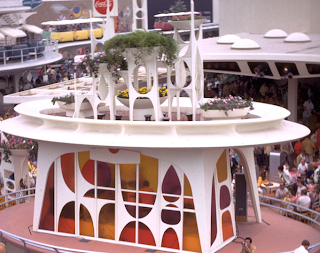 50 years ago, I was lucky enough to see the Stone Poneys at the Tomorrowland Terrace in Disneyland. Tomorrowland has always been problematic for Disney, the past of Frontierland or Main Street USA doesn't change; it's a different story trying to keep up with the future, but 1967's remodeled version of Tomorrowland was the perfect construct and vision of what the world would become. The buildings rose in a clean white symmetry and featured murals by Small World artist, Mary Blair. Across from the Carousel of Progress and America the Beautiful, the Tomorrowland Terrace would rise out of the ground with the band already playing; what had been a futuristic garden became a stage in the round. The Stone Poneys featured Linda Ronstadt and members of what would become the Eagles: Bernie Leadon, Glenn Frey, Don Henley and Randy Meisner. Linda was like a 60s poster child in a miniskirt and bare feet and of course the finale was Mike Nesmith’s "Different Drum." It was probably the first time I was ever in love. The Happiest Place on Earth featured a mix of musical styles from Harry James and John Denver to 80s quirky post-punk band Sparks.
50 years ago, I was lucky enough to see the Stone Poneys at the Tomorrowland Terrace in Disneyland. Tomorrowland has always been problematic for Disney, the past of Frontierland or Main Street USA doesn't change; it's a different story trying to keep up with the future, but 1967's remodeled version of Tomorrowland was the perfect construct and vision of what the world would become. The buildings rose in a clean white symmetry and featured murals by Small World artist, Mary Blair. Across from the Carousel of Progress and America the Beautiful, the Tomorrowland Terrace would rise out of the ground with the band already playing; what had been a futuristic garden became a stage in the round. The Stone Poneys featured Linda Ronstadt and members of what would become the Eagles: Bernie Leadon, Glenn Frey, Don Henley and Randy Meisner. Linda was like a 60s poster child in a miniskirt and bare feet and of course the finale was Mike Nesmith’s "Different Drum." It was probably the first time I was ever in love. The Happiest Place on Earth featured a mix of musical styles from Harry James and John Denver to 80s quirky post-punk band Sparks.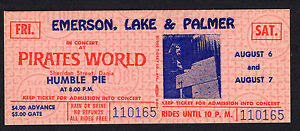 But while Disneyland could boast an eclectic selection of musical genres, it was an obscure theme park in Dania, Florida that would host some of the 60's best new bands. That theme park was Pirates World which opened in 1967 without really much of a theme, the pirate motif not fully realized. Still, there were great rides including the reconstructed Steeple Chase from Coney Island and a sky tower from the 1964 New York World’s Fair. The big attraction though was the summer concert series. Led Zeppelin played there twice; once in 1969 and once in 1971. 1970 had Iron Butterfly, Faces with Rod Stewart, the Grateful Dead, Traffic, Black Sabbath, Blood Sweat and Tears, Deep Purple with both Ritchie Blackmore and Ian Gillan and Johnny Winter would record his album Live Johnny Winter in 1970 with a release date in 1971.
But while Disneyland could boast an eclectic selection of musical genres, it was an obscure theme park in Dania, Florida that would host some of the 60's best new bands. That theme park was Pirates World which opened in 1967 without really much of a theme, the pirate motif not fully realized. Still, there were great rides including the reconstructed Steeple Chase from Coney Island and a sky tower from the 1964 New York World’s Fair. The big attraction though was the summer concert series. Led Zeppelin played there twice; once in 1969 and once in 1971. 1970 had Iron Butterfly, Faces with Rod Stewart, the Grateful Dead, Traffic, Black Sabbath, Blood Sweat and Tears, Deep Purple with both Ritchie Blackmore and Ian Gillan and Johnny Winter would record his album Live Johnny Winter in 1970 with a release date in 1971. 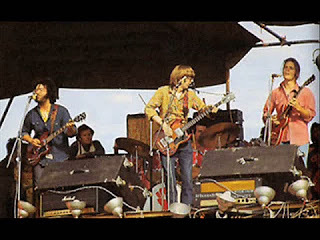 Grateful DeadJethro Tull, Grand Funk, The Steve Miller Band, the Moody Blues and Three Dog Night all played in 1971, David Bowie in 1972 along with Santana, and in 1973, Pirate's World hosted Alice Cooper and The Beach Boys. By 1973 Pirates World was experiencing hard times, with the concert venue being its only real success; it seems, up the road, a little place called Disney World had opened in 1971. Nonetheless, before the amusement park closed in 1976, the venue would feature Chicago, Steely Dan, Pink Floyd, Leon Russell, Badfinger and Emerson, Lake and Palmer. It sounds like a list from the Hollywood Bowl or Madison Square Garden; nope, little old Pirate's World.
Grateful DeadJethro Tull, Grand Funk, The Steve Miller Band, the Moody Blues and Three Dog Night all played in 1971, David Bowie in 1972 along with Santana, and in 1973, Pirate's World hosted Alice Cooper and The Beach Boys. By 1973 Pirates World was experiencing hard times, with the concert venue being its only real success; it seems, up the road, a little place called Disney World had opened in 1971. Nonetheless, before the amusement park closed in 1976, the venue would feature Chicago, Steely Dan, Pink Floyd, Leon Russell, Badfinger and Emerson, Lake and Palmer. It sounds like a list from the Hollywood Bowl or Madison Square Garden; nope, little old Pirate's World.
Published on August 24, 2019 17:55
August 20, 2019
CSN - Y, Too
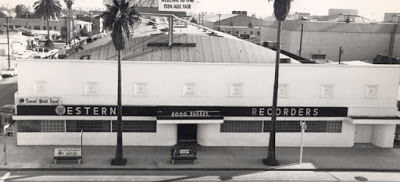 In June 1966, Graham Nash and the Hollies met the Mamas and the Papas at a Hollies press party at Imperial Records. Nash hit it off right away with Cass Elliot and Cass who invited Graham to a Mamas and Papas recording session of "Dancing Bear" at Western Recorders on Sunset Boulevard. Fast forward to February 1968 where the Hollies played a Valentine's gig at the Whiskey a Go-Go. Micky Dolenz introduced the show and Stephen Stills and David Crosby were right up front. In April, Cass would introduce Nash to Crosby and Stills at her house in Laurel Canyon and the catalyst for CSN was set into motion. By the end of 1968, Nash took leave of the Hollies, content to consider his future from the restorative oasis that was Laurel Canyon, not to mention his Our House kind of life with Joni Mitchell. We've talked before about the haphazard way in which bands, particularly supergroups are formed. It was fifty years ago that the CSN's eponymous LP was released and none of its luster is lost 50 years on. "Suite: Judy Blue Eyes," alongside "Wooden Ships," "Helplessly Hoping," and "Guinevere" sound as fresh today as anything by Lord Huron, Fleet Foxes or the new Americana sounds.
In June 1966, Graham Nash and the Hollies met the Mamas and the Papas at a Hollies press party at Imperial Records. Nash hit it off right away with Cass Elliot and Cass who invited Graham to a Mamas and Papas recording session of "Dancing Bear" at Western Recorders on Sunset Boulevard. Fast forward to February 1968 where the Hollies played a Valentine's gig at the Whiskey a Go-Go. Micky Dolenz introduced the show and Stephen Stills and David Crosby were right up front. In April, Cass would introduce Nash to Crosby and Stills at her house in Laurel Canyon and the catalyst for CSN was set into motion. By the end of 1968, Nash took leave of the Hollies, content to consider his future from the restorative oasis that was Laurel Canyon, not to mention his Our House kind of life with Joni Mitchell. We've talked before about the haphazard way in which bands, particularly supergroups are formed. It was fifty years ago that the CSN's eponymous LP was released and none of its luster is lost 50 years on. "Suite: Judy Blue Eyes," alongside "Wooden Ships," "Helplessly Hoping," and "Guinevere" sound as fresh today as anything by Lord Huron, Fleet Foxes or the new Americana sounds.Interestingly, one of the most famous of the CSN debut tracks was "Marrakesh Express," a song Nash had written for the Hollies. He said he was in England reading about the middle eastern journeys of William Burroughs and Allen Ginsberg. Here I quote: "So, I grab my wife, Rose, and we took the train down from Casablanca down to Marrakesh. All my pores were open. I was just soaking in this atmosphere." That in mind, listen to the track again to get the vibe and imagine the scene. He said, "I was carrying all these tunes in my pocket just waiting for the right moment." Donovan had fostered the notion that Nash could make it on his own, and in the meantime taught him to fingerpick. Nash found himself floundering in the Hollies who weren’t receptive to songs like "Marrakesh Express" or "Teach Your Children" and when he met Crosby, Crosby said, "Don’t even listen to what they are saying. They're totally fucked. I love those songs."
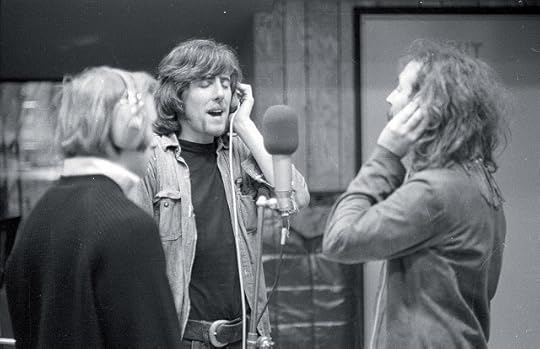 There is little on the LP that doesn't work. With its soaring harmonies and layered guitars, "Suite: Judy Blue Eyes" is an epic opener, one that even FM overkill can't kill. "Marrakesh Express" is infectious, "Guinevere" is an ethereal masterpiece that delicately conveys the sense of drugged-up wonder in which Crosby was immersed at the time. And "Wooden Ships" is amazing. The lyrics speak of a post-apocalyptic world when human beings finally realize that we cannot be enemies and survive. "Long Time Gone" is an angry yet heart-wrenching track on the assassination of RFK. Crosby's delivery is impeccable. And finally, we get "49 Bye-Byes," a closer worthy of the awe-inspiring music that has come before it.
There is little on the LP that doesn't work. With its soaring harmonies and layered guitars, "Suite: Judy Blue Eyes" is an epic opener, one that even FM overkill can't kill. "Marrakesh Express" is infectious, "Guinevere" is an ethereal masterpiece that delicately conveys the sense of drugged-up wonder in which Crosby was immersed at the time. And "Wooden Ships" is amazing. The lyrics speak of a post-apocalyptic world when human beings finally realize that we cannot be enemies and survive. "Long Time Gone" is an angry yet heart-wrenching track on the assassination of RFK. Crosby's delivery is impeccable. And finally, we get "49 Bye-Byes," a closer worthy of the awe-inspiring music that has come before it. Three months later, without any rehearsal time, the trio got together with Neil Young to play Woodstock. There are but a handful of important sets at Woodstock – Santana, Joe Cocker, Hendrix, but it was Crosby, Stills, Nash and Young who epitomized what Woodstock was all about.
Two interesting things. The band was at first introduced as Buffalo Springfield, which of course was inaccurate, and following an incredible set with just Crosby, Stills and Nash, Young milling about in the background of what is referred to as the acoustic session (only joining in for two songs), the rest of the show was a hard-rocking guitar-oriented session with Stills and Young taking the reins. The band, of course, would go on to release Déjà vu just a few months later, which remains one of rock's timeless gems and includes the popularized version of Joni Mitchell's "Woodstock."
Published on August 20, 2019 17:29
August 19, 2019
Woodstock No Shows
While the immensity and importance of the Aquarian Exposition cannot be denied, from a critical standpoint and with few exceptions, Monterey exceeded expectations whereas Woodstock, due primarily to the weather and technical difficulties was oftentimes underwhelming. Some artists like Creedence Clearwater and the Grateful Dead had such lackluster performances that the bands were excluded from both the film and the soundtrack. Obviously, we didn't celebrate the 50th anniversary of Monterey the way that we've looked back on Woodstock; there is no Monterey Pop museum, it's the spirit of Woodstock, therefore, that enraptures us, alongside the handful of standout performances from Joe Cocker, Santana, Hendrix, and Crosby, Stills, Nash and Young. But what of those artists who didn’t get to Woodstock?
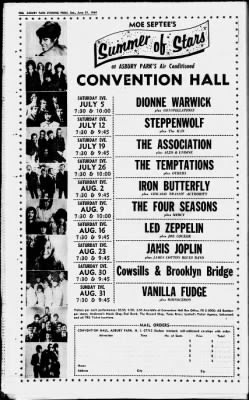 We've posted about this before. Putting the pieces together in the rock era is a hit or miss undertaking in that so much of it is speculation, as much of it, hearsay. At the book signing for Miles From Nowherelast week, I met a Woodstock attendee who insisted that Tiny Tim was the first performer on Day 1 of the festival. No evidence supports this; Tiny Tim wasn't at Woodstock, despite how real the memory may have been to this gentleman. And so, when we look at who didn’t play Woodstock, we’re faced with the same kind of sketchy speculation. John Lennon, for instance, was asked if The Beatles would consider performing. Many insist that Lennon said The Beatles would only appear if Yoko and the Plastic Ono Band were also on the docket. Again, there is no record of this. The more likely story is that, based on Lennon's issues with Richard Nixon, there was no way for Lennon to enter the United States in August 1969.
We've posted about this before. Putting the pieces together in the rock era is a hit or miss undertaking in that so much of it is speculation, as much of it, hearsay. At the book signing for Miles From Nowherelast week, I met a Woodstock attendee who insisted that Tiny Tim was the first performer on Day 1 of the festival. No evidence supports this; Tiny Tim wasn't at Woodstock, despite how real the memory may have been to this gentleman. And so, when we look at who didn’t play Woodstock, we’re faced with the same kind of sketchy speculation. John Lennon, for instance, was asked if The Beatles would consider performing. Many insist that Lennon said The Beatles would only appear if Yoko and the Plastic Ono Band were also on the docket. Again, there is no record of this. The more likely story is that, based on Lennon's issues with Richard Nixon, there was no way for Lennon to enter the United States in August 1969. Led Zeppelin declined the offer to appear and instead launched a successful tour of the U.S., playing at the Asbury Park Convention Center over Woodstock weekend and then in Framingham, Massachusetts at the Carousel, which was hopefully, faithfully, brought to life in Miles From Nowhere.
It was thought the Dylan would appear but based on his son's illness and a distaste for the hippies who'd been congregating outside his home in Woodstock, Bob declined the invitation.
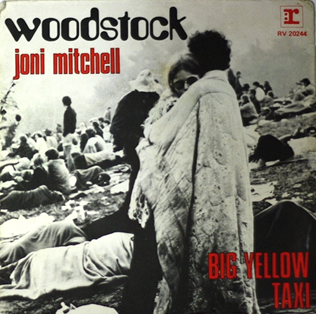 John Densmore said that the Doors didn't play because Morrison didn’t like to perform outdoors. Both the Moody Blues and Procol Harum appear on the original roster with each dropping out of the lineup in the weeks prior.
John Densmore said that the Doors didn't play because Morrison didn’t like to perform outdoors. Both the Moody Blues and Procol Harum appear on the original roster with each dropping out of the lineup in the weeks prior.The Jeff Beck group broke up a week before the festival and Tommy James said that someone approached him and said, "Yeah, listen, there's this pig farmer in upstate New York that wants you to play in his field." The Shondells subsequently passed up the invitation.
Most significantly, Joni Mitchell was advised by her manager to appear on the Dick Cavett program rather than attending Woodstock feeling that it would be more beneficial to her career. In the history of rock, the only decision that I can think of that may be worse than Joni's was Pete Best leaving the Beatles. What's interesting to note is that Joni, despite not being at the festival, wrote the festival's unofficial anthem shortly thereafter, a track that would be included on her album Ladies of the Canyon in 1970 and made famous by Crosby stills Nash and Young on their LP Déjà Vu.
Last, Iron Butterfly were scheduled to appear but were stranded at the airport. While acts like CSNY got lifted in by helicopter, the Iron Butterflyhowever, weren't offered the same courtesy and never made it to their Gadda Da Vida.
Published on August 19, 2019 05:44
August 18, 2019
Hendrix - Woodstock
 Of Santana's monumental performance, weeks before their debut LP was released, Carlos Santana said, "It was very memorable and monumental. We didn't know that there were so many people in the '60s that wanted to stop the war. People got involved in the '60s, with the Black Panthers and the students. We wanted to change the world, like Jim Morrison, from The Doors, said: 'We want the world and we want it now.' I didn't realize till we got to Woodstock just how many freaks [there were] at Woodstock. There were women and men, an ocean of hearts screaming. I use this word 'freaks' as a positive thing. Freaks are great. Freak is a good word, because you're outside of the normal," he told Billboard. "We all wanted Vietnam to stop. We wanted to be liberated, emancipated from mental slavery. We are one family at Woodstock." Woodstock was indeed about peace, about love and of course about the music, but it was also a portrait of our nation's youth, struggling with parents and a generation who could not understand the dissent. It was a generation intent, not on preserving the American way of old, but one that dismissed many of the ideals held in such esteem in America's bedroom communities.
Of Santana's monumental performance, weeks before their debut LP was released, Carlos Santana said, "It was very memorable and monumental. We didn't know that there were so many people in the '60s that wanted to stop the war. People got involved in the '60s, with the Black Panthers and the students. We wanted to change the world, like Jim Morrison, from The Doors, said: 'We want the world and we want it now.' I didn't realize till we got to Woodstock just how many freaks [there were] at Woodstock. There were women and men, an ocean of hearts screaming. I use this word 'freaks' as a positive thing. Freaks are great. Freak is a good word, because you're outside of the normal," he told Billboard. "We all wanted Vietnam to stop. We wanted to be liberated, emancipated from mental slavery. We are one family at Woodstock." Woodstock was indeed about peace, about love and of course about the music, but it was also a portrait of our nation's youth, struggling with parents and a generation who could not understand the dissent. It was a generation intent, not on preserving the American way of old, but one that dismissed many of the ideals held in such esteem in America's bedroom communities. Bobbi Kelly and Nick Ercoline Greet the Sun and Become an Icon
Bobbi Kelly and Nick Ercoline Greet the Sun and Become an IconDuring The Who's performance, which ended at dawn, Sunday morning, the concert's only real controversy arose when Abbie Hoffman rushed the stage during a break in the set. The activist took over the PA in a semi-coherent rant about freeing John Sinclair from jail. Pete Townshend turned, yelled at Hoffman to get off "my stage," and hit the activist in the head with the neck of his guitar.
By Sunday the world was already experiencing the shock of the new through newspaper and television coverage, but within the festival grounds, it was still about the music. Joe Cocker was the first act on the last officially booked day (Sunday, August 17th), opening for the day's booked acts at 2:00pm. The incessant rain ultimately delayed the schedule nine hours. By dawn (Monday morning), the concert continued despite most attendees having left, returning to the working week and other normalobligations.
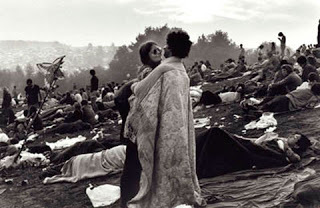 A Rarely Seen Alternate ShotTen Years After, Blood, Sweat and Tears and Johnny Winter would all have commendable sets that afternoon, but it was Crosby, Stills and Nash who stole the show on Sunday, with Neil Young on stage as well, who refused to be filmed. Crosby, Stills, Nash and Young had played only one previous show prior to Woodstock, and although each member was experienced in the rock circuit, the lack of playing together left them incredibly nervous; the gravitas of the festival fully apparent by day three. The set included acoustic performances of songs from the first album released without Young (Crosby, Stills & Nash – AM10), who played as a duo with Stills during the performance. The pair were introduced as Buffalo Springfield, although they'd disbanded in 1968. After their sink or swim induction into the rock 'n' roll world at Woodstock, they followed up with their first release as a quartet titled Déjà Vu (AM10), which topped the charts and produced three hit singles. In addition to the Stills/Young duet, the CSNY set included two separate components; the first acoustic, the latter electric.
A Rarely Seen Alternate ShotTen Years After, Blood, Sweat and Tears and Johnny Winter would all have commendable sets that afternoon, but it was Crosby, Stills and Nash who stole the show on Sunday, with Neil Young on stage as well, who refused to be filmed. Crosby, Stills, Nash and Young had played only one previous show prior to Woodstock, and although each member was experienced in the rock circuit, the lack of playing together left them incredibly nervous; the gravitas of the festival fully apparent by day three. The set included acoustic performances of songs from the first album released without Young (Crosby, Stills & Nash – AM10), who played as a duo with Stills during the performance. The pair were introduced as Buffalo Springfield, although they'd disbanded in 1968. After their sink or swim induction into the rock 'n' roll world at Woodstock, they followed up with their first release as a quartet titled Déjà Vu (AM10), which topped the charts and produced three hit singles. In addition to the Stills/Young duet, the CSNY set included two separate components; the first acoustic, the latter electric.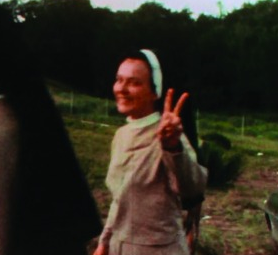 Sister Susanne BunnAs most people assume that the Aquarian Exposition was held in Woodstock, many are also under the impression that the song, "Woodstock," was played at the concert. It is perhaps ironic that the artist who, for some, defines the Woodstock Festival was not actually there. Like a lot of artists who should have performed, who one fancifully imagines did perform, Joni Mitchell was a part of an absentee list that included Dylan, Led Zeppelin, Love and the Doors. Joni's manager insisted that keeping a scheduled interview on The Dick Cavett Show was more beneficial to her career. Sitting in her hotel room awaiting her appearance, Mitchell watched what has come to be regarded as the defining event of the Aquarian Age unfolding before her eyes in a series of television news bulletins. Woodstock, she would later state "struck her like a modern-day fishes and loaves story. For a herd of people that large to co-operate so well, it was pretty remarkable, and there was a tremendous optimism. So I wrote the song 'Woodstock' out of these feelings."
Sister Susanne BunnAs most people assume that the Aquarian Exposition was held in Woodstock, many are also under the impression that the song, "Woodstock," was played at the concert. It is perhaps ironic that the artist who, for some, defines the Woodstock Festival was not actually there. Like a lot of artists who should have performed, who one fancifully imagines did perform, Joni Mitchell was a part of an absentee list that included Dylan, Led Zeppelin, Love and the Doors. Joni's manager insisted that keeping a scheduled interview on The Dick Cavett Show was more beneficial to her career. Sitting in her hotel room awaiting her appearance, Mitchell watched what has come to be regarded as the defining event of the Aquarian Age unfolding before her eyes in a series of television news bulletins. Woodstock, she would later state "struck her like a modern-day fishes and loaves story. For a herd of people that large to co-operate so well, it was pretty remarkable, and there was a tremendous optimism. So I wrote the song 'Woodstock' out of these feelings."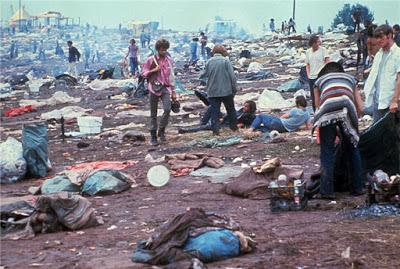 The Paul Butterfield Blues Band and 50s era cover band Sha Na Na, possibly the least apropos act signed on to the festival, followed; Sha Na Na performing at the break of dawn, Monday morning.
The Paul Butterfield Blues Band and 50s era cover band Sha Na Na, possibly the least apropos act signed on to the festival, followed; Sha Na Na performing at the break of dawn, Monday morning. Jimi Hendrix insisted on being the final performer of the festival and was scheduled to perform at midnight. Due to the various delays, he did not take the stage until 9:00am on Monday. The crowd, estimated at over 450,000 at its peak, is reported to have been no larger than 80,000 when his performance began (with possibly as few as 25,000). His set lasted two hours - the longest of his career - and featured 17 songs, concluding with "Hey Joe," which was played to a relatively empty field.
Published on August 18, 2019 04:22
Miles From Nowhere - Hendrix
 In the dawn's light we witnessed those who remained, the chemically disoriented throngs covered in dried mud. The knoll above the stage was scattered with people and garbage and muck. We retreated to the Hatfield's and found our way inside. People were sleeping, Hatfield was making scrambled eggs, there was coffee and we ate. I needed food. I'd left my medication in the van. I felt weak and my face felt rubbery, but no one said a thing.
In the dawn's light we witnessed those who remained, the chemically disoriented throngs covered in dried mud. The knoll above the stage was scattered with people and garbage and muck. We retreated to the Hatfield's and found our way inside. People were sleeping, Hatfield was making scrambled eggs, there was coffee and we ate. I needed food. I'd left my medication in the van. I felt weak and my face felt rubbery, but no one said a thing. I heard someone say, "Bethel's in the Bible, man. It's the place where Jacob envisioned a stairway to Heaven; the messengers of God going up it and down it." We curled up on an Indian blanket and fell asleep. "Up and down they tramped in the glory of God."
The music, like a dream soundtrack, was familiar, heavy and discordant. I opened my eyes. Farm Girl was drooling on my sleeve. "Come-on. Come-on." It was Hendrix. Jimi was playing "Foxy Lady." The time had come. My father told me all about the journey. He was a journeyman. But it was nice when you got there; when you arrived. Farm Girl and I slipped through the barrier that was now but an accordion of mangled wire mesh. The pyramid of storage boxes was in ruin, much of it poached or toppled, but the fences of Woodstock's DMZ were down and we ambled through the crowd unencumbered. There were throngs of people leaving. I was still perplexed. "Where are they going," I said. I found it disconcerting. "Why are they going?"
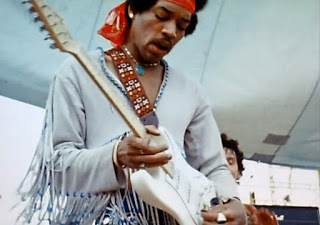 "It’s not about them," Farm Girl said, and then Jimi chimed in, "You can leave if you want to. We’re just jammin', that's all." Those who remained were huddled together, loosely, the band of brothers and sisters like the holocaust aftermath in a science fiction film. Hendrix played "Izabella" and "Gypsy Woman" and "Fire," and then the best; Jimi and the band in radical improvisation, offbeat and discordant, a cacophony both jarring and harmonious.
"It’s not about them," Farm Girl said, and then Jimi chimed in, "You can leave if you want to. We’re just jammin', that's all." Those who remained were huddled together, loosely, the band of brothers and sisters like the holocaust aftermath in a science fiction film. Hendrix played "Izabella" and "Gypsy Woman" and "Fire," and then the best; Jimi and the band in radical improvisation, offbeat and discordant, a cacophony both jarring and harmonious.I blocked it all out, the mud people, the stage, even Farm Girl or my father or Lori or my illness; it was all just Jimi, shining there before me in white leather fringe, his Stratocaster upside down and backward. He was the alpha and the omega. He launched into the "Star-Spangled Banner," his guitar so pure and piercing, its dissonance all the news one needed to comprehend the times, the war, the assassinations. He initiated the fire of guns, the bombs bursting in air, all within the confines of a white Fender guitar. It said far more about the timber of America than a hundred partisan tirades.
 But I didn't care about protest and bombs. It was just the sonic possibilities of music. Jimi didn't pluck strings, he whacked them and thwacked them and let the amp's reverberation recirculate through the pickups in a loop of feedback, the guitar virtually playing itself.
But I didn't care about protest and bombs. It was just the sonic possibilities of music. Jimi didn't pluck strings, he whacked them and thwacked them and let the amp's reverberation recirculate through the pickups in a loop of feedback, the guitar virtually playing itself.He played "Purple Haze" and "Hey Joe" and I burst into tears. I sat on the muddy knoll and cried; great tears of sorrow and of joy coursing through me simultaneously. I pulled my knees up and rested my head and that was that. Woodstock was over. I sat for a very long time.
The residue of acid and emotion flew from me suddenly, like a demon exorcised. I looked up and I was alone on Yasgur's Farm. Farm Girl was gone, there was no one on stage, the faithful retraced their steps back to their cars and their homes. I was adrift in a sea of garbage and swill.
And then I saw Farm Girl. In that magic bag of hers, she'd found another outfit, bell-bottomed dungarees and a halter top. She looked fresh and clean somehow and I was filthy like a pig in a sty. She took my mud-crusted mitt in hers and pulled me to my feet. She said, "I'm leaving with the Hatfields," or whatever their name was.
"Oh. You are," I said.
"I am. I have to get home. My family's waiting for me. They worry."
"'Kay."
"I enjoyed our time together. Really. You're a real nice guy." What do you say to that, "Thanks"? What was I going to do, cry out, No, wait, don't go? Of course not. Our parting was inevitable. It just would have been nice to have a little lunch or something, share a meal.
"It was nice." She smiled. "Prettiest smile."
"Hardly." She laughed. "Big ol' space in my teeth. Should of had braces."
"Don't."
"Can't afford it anyway."
"Don't." She hugged me and I kissed her and she walked down the knoll. She didn't turn back. Hatfield was meticulously loading a big bolt of green canvas onto the bed of a truck. He put up the tailgate and the truck pulled away. The little boy saw me up the hill and he waved. So did Hatfield. They got in an orange and white Econoline panel truck. I would have thought a wagon with two black mules. Mrs. Hatfield and Farm Girl got in the other side and they fell in line, the caravan slowly pulling onto the highway. I wasn't feeling sorry for myself, I'd been over that for a long time, but the song in my head was "Fool On the Hill."
It dawned on me that I didn't have any shoes. I watched as the Econoline sat at the intersection, its blinker on. And then it was gone. I walked down the hill and through the trenches. I crossed over the planks and the downed fence to where the tent had been. There was a cardboard box. In it were my shoes and a sandwich and a guitar pick. Maybe it was Jimi's. Maybe it was Hatfield's. Didn't matter. It was nice to have shoes and a sandwich and a souvenir.

- From the novel Miles from Nowhere
Published on August 18, 2019 00:28
August 17, 2019
Miles From Nowhere
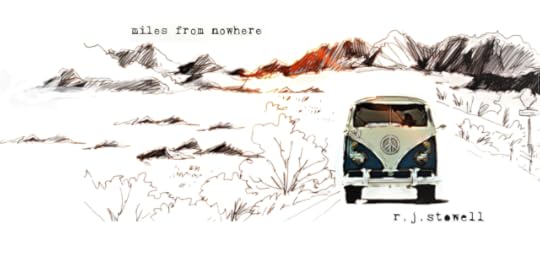 Miles From Nowhere, which is, of course, a novel about Woodstock, is available on Amazon, and for your Kindle! We've kept the price affordable and also arranged for you to read the novel on Kindle Unlimited for free, order the Kindle version for $2.99 or the softbound copy for $10.99. Miles From Nowhere is a rock 'n' roll pilgrimage, the journey of a young man in poor health as he travels from California to Woodstock to see his idol, Jimi Hendrix. Along the way he meets friends and family, an entourage of hippies and bohemians, musicians and socialites; every time you put the novel down you'll have another familiar song in your head.
Miles From Nowhere, which is, of course, a novel about Woodstock, is available on Amazon, and for your Kindle! We've kept the price affordable and also arranged for you to read the novel on Kindle Unlimited for free, order the Kindle version for $2.99 or the softbound copy for $10.99. Miles From Nowhere is a rock 'n' roll pilgrimage, the journey of a young man in poor health as he travels from California to Woodstock to see his idol, Jimi Hendrix. Along the way he meets friends and family, an entourage of hippies and bohemians, musicians and socialites; every time you put the novel down you'll have another familiar song in your head. Order your copy of Miles From Nowhere on Amazon or click the links in the sidebar. Order here on the website and get a personally autographed copy!
Published on August 17, 2019 07:02
Woodstock Live! - 1969 Transcript - Day 3
Woodstock Live! Day 3 – Transcript
 I just came back into the Hatfield’s tent. I’m here with a couple of young people I met when we first arrived, a young guy named Miles and his girl, Hadley. They just got here today, and Hatfield invited them in, same as me. I guess they, too, looked hungry.
I just came back into the Hatfield’s tent. I’m here with a couple of young people I met when we first arrived, a young guy named Miles and his girl, Hadley. They just got here today, and Hatfield invited them in, same as me. I guess they, too, looked hungry. As expected, Joe Cocker was sensational. Here was one of the great performances I’ve seen in my lifetime, and what a crowd pleaser, particularly “Feeling All Right” and a rendition of “With a Little Help From My Friends” that rivals the Beatles’. After a weather reprieve that lasted most of the day, it’s raining again. Country Joe and the Fish played mostly during the rain, but in an iconic Woodstock moment, the whole of the half-million sang a chorus of the “Fish Cheer.” While there has been a myriad of technical issues that weren’t a part of Monterey - in that respect, the performances there outshining those here at Woodstock - there’s a spirit here that cannot be matched. I am overwhelmed, working on very little sleep, and on sensory overload. I am so exhausted that I missed several bands this afternoon simply because you, you just can’t stay awake for three days.
I caught a little bit of Blood, Sweat and Tears. The enthusiasm of the crowd for the diversity of music is quite striking, with the stand-out from what is essentially a jazz band being their rendition of Billy Holiday’s “God Bless the Child.”
…It’s 3 AM. It’s been quiet, dead quiet for the past half hour but now, maybe in the background you can hear Crosby, Stills and Nash. Miles, Hadley and I are headed out to watch the show. The Hatfield’s tent isn’t that far from the stage and a chain link fence lying on its side allows us easy access front and center. Better though, there’s a section off to the side where they’re storing all the amps and hardware that kind of looks like a Mayan pyramid. Miles and Hadley are climbing up top. There are indeed people falling in love here, and rumor has it, even, that a baby was born. Despite a message to avoid the brown acid and the occasion freak out, this has become a lawful and happy community. It’s quite endearing.
…The announcer said “Crosby stills Nash and Young” but I’m not seeing Young.
Young has pretty much kept to himself for most of what they’ve called the acoustic set, only out front for “Mr. Soul.” They’ve just done an electric set with Neil kind of hanging about in the shadows, definitely defining the sound yet he seems pretty apprehensive about all the cameraman, the technicians and all their ballyhoo, and honestly, it can be a little distracting.
As we speak, though, another great moment, folks. I mean, there are four or 500,000 people here and you can hear a pin drop. The song is an a cappella tune that has the crowd mesmerized called “Find the Cost of Freedom.” If I had to pick just one tune, this would be Woodstock’s anthem.
Well folks, I’m going to join Hadley and Miles at the top of the Mayan pyramid and enjoy the rest of the set. This is R.J. Stowell reporting live from Woodstock.
Published on August 17, 2019 06:32
August 16, 2019
The Brown Acid Circulating Around
Early on Friday afternoon about a dozen of us got together and spread out some blankets on the grass at a spot about a third of the way up the hill on stage right and then dropped LSD. I took Orange Sunshine, a strong, clean dose in an orange tab that was perhaps the best street acid ever. Underground chemists in southern California had made millions of doses, and the nation was flooded with it that summer. We smoked some tasty black hashish to amuse ourselves while waiting for the acid to hit, and sat back to groove along with Richie Havens.In two hours we were all soaring, and everything was just fine. In fact, it couldn't have been better - there I was with my beautiful girlfriend and all my hometown friends, higher than a church steeple and listening to wonderful music in the cool summer weather of the Catskills. After all, the dirty little secret of the late '60s was that psychedelic drugs taken in a pleasant setting could be completely exhilarating.
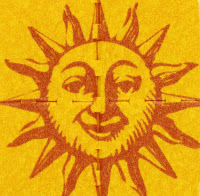 That account is just one of hundreds about tripping at Woodstock, and unlike the bad press and bad trip exposés more readily portrayed about psychedelics, the account above is more typical. Realizing, though, that bummer trips would pervade the concert, festival organizers erected "Bad Trip Tents," colloquially referred to as “Freak Out Tents.” Concertgoers experiencing bad LSD trips came to, or were brought to, the tents in order to work through the moment. Medical personnel and members of the Hog Farm Commune manned the facilities. The Hog Farmers treated bad acid trips with hugs and soft words. "You had to give them some touch with reality. You had to speak softly," said one of the workers. Medics had Thorazine on hand, an anti-psychotic drug, to chemically counteract the negative LSD experience, but the tripsters insisted that Thorazine would send a drug user further down the spiral, leading to long-term psychological issues.
That account is just one of hundreds about tripping at Woodstock, and unlike the bad press and bad trip exposés more readily portrayed about psychedelics, the account above is more typical. Realizing, though, that bummer trips would pervade the concert, festival organizers erected "Bad Trip Tents," colloquially referred to as “Freak Out Tents.” Concertgoers experiencing bad LSD trips came to, or were brought to, the tents in order to work through the moment. Medical personnel and members of the Hog Farm Commune manned the facilities. The Hog Farmers treated bad acid trips with hugs and soft words. "You had to give them some touch with reality. You had to speak softly," said one of the workers. Medics had Thorazine on hand, an anti-psychotic drug, to chemically counteract the negative LSD experience, but the tripsters insisted that Thorazine would send a drug user further down the spiral, leading to long-term psychological issues. 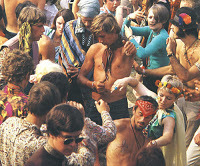 The tents were divided into three wards to cover incoming casualties. The first was the Freak Out ward. A second, the largest, was for people with cut feet; broken glass and pop-tops littered the venue like a killing field. The third area was for people with a malady peculiar to Woodstock. "They burned their eyes staring at the sun," one worker said. "If they were tripping, they'd lie down on their backs and just stare. There were five or six or seven at a time. That was something." Despite the accounts, and based on the amount of rain, the latter seems more than a little far-fetched. As with nearly everything at Woodstock, eyewitness accounts were unreliable at best.
The tents were divided into three wards to cover incoming casualties. The first was the Freak Out ward. A second, the largest, was for people with cut feet; broken glass and pop-tops littered the venue like a killing field. The third area was for people with a malady peculiar to Woodstock. "They burned their eyes staring at the sun," one worker said. "If they were tripping, they'd lie down on their backs and just stare. There were five or six or seven at a time. That was something." Despite the accounts, and based on the amount of rain, the latter seems more than a little far-fetched. As with nearly everything at Woodstock, eyewitness accounts were unreliable at best.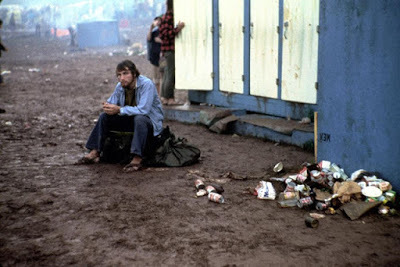 During the festival, Edward "Chip" Monck served as Woodstock's master of ceremonies. Anyone who has ever seen the film knows of his somewhat deadpan, but genuine announcements over the PA, including his famous warning: "Uh, to get back to the warning that I’ve received, you might take it with however many grains of salt you wish, that the brown acid that is circulating around us is not specifically too good. It's suggested that you do stay away from that. Of course it’s your own trip, so be my guest. But please be advised that there’s a warning on that one, okay?" But what was the brown acid? Here we can only surmise. Theoretically, LSD is often put onto blotter paper adorned with colors or extravagant artwork, everything from R. Crumb drawings to psychedelic patterns. Long before Woodstock, the myth had developed about the quality of the LSD based on the color or artwork on the blotter paper. The blue acid might give you more of a body trip, while the red tabs, a head trip. The theory doesn't fly on a number of levels though. Pure Lysergic Acid Diethylamide 25 was legal in 1968 and still plentiful in 1969; high quality LSD was commonplace. Blotter was only really identified during the mid-70s.
During the festival, Edward "Chip" Monck served as Woodstock's master of ceremonies. Anyone who has ever seen the film knows of his somewhat deadpan, but genuine announcements over the PA, including his famous warning: "Uh, to get back to the warning that I’ve received, you might take it with however many grains of salt you wish, that the brown acid that is circulating around us is not specifically too good. It's suggested that you do stay away from that. Of course it’s your own trip, so be my guest. But please be advised that there’s a warning on that one, okay?" But what was the brown acid? Here we can only surmise. Theoretically, LSD is often put onto blotter paper adorned with colors or extravagant artwork, everything from R. Crumb drawings to psychedelic patterns. Long before Woodstock, the myth had developed about the quality of the LSD based on the color or artwork on the blotter paper. The blue acid might give you more of a body trip, while the red tabs, a head trip. The theory doesn't fly on a number of levels though. Pure Lysergic Acid Diethylamide 25 was legal in 1968 and still plentiful in 1969; high quality LSD was commonplace. Blotter was only really identified during the mid-70s. 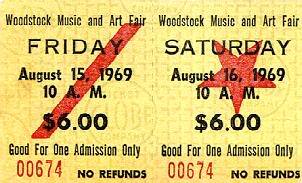 More likely, it was summer, you were young and stupid and in an environment so magical that chemical enhancement seemed but an elixir, a potion - and Sly wanted to take you higher. And someone comes up and offers tabs of the compound at a dollar a pop. Having no clue about anything and giddy as a five-year-old at Disneyland, you're advised to eat 2 hits to "see the light," and surprise, you've just had the infamous brown acid. More than likely, the acid you ate isn't bad at all, but quite the opposite. It's as pure, as clean, as perfectly synthesized as it could ever or would ever possibly be. Reality: you just ate 800mcg of the strongest chemical in the history of, like, drugs. Most of Woodstock’s attendees just weren't ready for that kind of mind altering state in a venue that was far from sobering; indeed, it was as surreal as a de Chirico painting, but one way or another, the brown acid was "not specifically too good."
More likely, it was summer, you were young and stupid and in an environment so magical that chemical enhancement seemed but an elixir, a potion - and Sly wanted to take you higher. And someone comes up and offers tabs of the compound at a dollar a pop. Having no clue about anything and giddy as a five-year-old at Disneyland, you're advised to eat 2 hits to "see the light," and surprise, you've just had the infamous brown acid. More than likely, the acid you ate isn't bad at all, but quite the opposite. It's as pure, as clean, as perfectly synthesized as it could ever or would ever possibly be. Reality: you just ate 800mcg of the strongest chemical in the history of, like, drugs. Most of Woodstock’s attendees just weren't ready for that kind of mind altering state in a venue that was far from sobering; indeed, it was as surreal as a de Chirico painting, but one way or another, the brown acid was "not specifically too good."
Published on August 16, 2019 06:20
Woodstock Live Update - Day 2
Woodstock, Live. Transcript – 8.16.69
 It’s the afternoon of August 16th. Late last night my crew and I headed back to the AM van to get out of the rain, which has turned all of Yasgur’s Farm into mud. This afternoon, John Sebastian from the Lovin’ Spoonful played an all acoustic set because everything was so wet he couldn’t use his his electric guitar. As he finished up, the sun made an effort, but as you can hear, it’s really coming down again.
It’s the afternoon of August 16th. Late last night my crew and I headed back to the AM van to get out of the rain, which has turned all of Yasgur’s Farm into mud. This afternoon, John Sebastian from the Lovin’ Spoonful played an all acoustic set because everything was so wet he couldn’t use his his electric guitar. As he finished up, the sun made an effort, but as you can hear, it’s really coming down again.
I’ll keep you posted as the day goes on, Canned Heat up next, can’t wait for that, then Mountain, the Grateful Dead and Creedence Clearwater…
…Due to the rain, Canned Heat didn’t come on until until 7:30 tonight with an hour long set that included “Up the Country” and a rousing finale with “On the Road Again.” I’m gonna try to find someplace to warm up a little bit; most of the crew has gone back to the van. Me, I’m like a kid in a candy store. I don’t wanna miss a thing…
…Well, I couldn’t believe this - I didn’t walk 50 paces until I came upon what seemed like a moderately sized tent with a crowd of people that could have been the Hatfields and the McCoy‘s. Hatfield was out front barbecuing. I guess I looked hungry, so they invited me in. Inside was a pleasant environment with feather beds all over the floor. This is really the spirit of Woodstock.
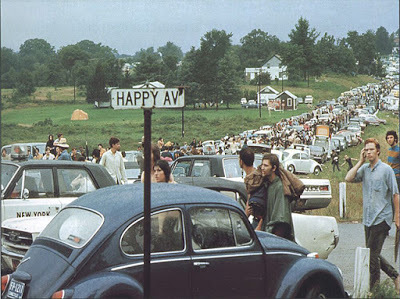
You may hear Creedence in the background with Janis on deck. Credence didn’t come on until 12:30 AM, about five hours later than expected and I guess Janis is going to come on at 2 o’clock or so, something like that. Doesn’t matter, the crowd is electric. After a slow start yesterday, kind of a mellow afternoon, today’s festivities are just overwhelming. Wait, listen up. My host, you know, Hatfield, is playing guitar…
…I fell asleep on the floor here in the Hatfield’s tent, I just woke up; it’s almost 6am. The Who is up on stage. I missed most of the set, but now they’re playing “My Generation.” Seems to be the encore. I was going to head outside and watch the end of the act but it has just started raining hard once again. I’m going to hang tight here, warm and dry, until Jefferson Airplane…
…Well, this is fantastic, folks. It’s at the Jefferson Airplane in one of the best moments of Woodstock so far. Just when you thought that their time had passed, here was the most electrifying sets of the night. I say night, but it’s nearing 8 o’clock in the morning. The sun is up once again and I do indeed mean the sun, and not just hazy gray mist. A great set by the Airplane that begain with “Somebody to Love” then “3/5 of a Mile In 10 seconds” and a crowd pleasing rendition of “Volunteers.” “White Rabbit” was of course the morning’s highlight, despite the sound system and the rain and mud, and I am starving. Still there’s just an incredible amount of enthusiasm from the crowd and a great performance by Grace Slick, Paul Kanter and Marty Balin; just an incredible performance. Have I said incredible enough yet?
Tomorrow, guys it’s Joe Cocker. Let me tell you, the audience is in for it. Most of them never having heard Joe Cocker. What a performer. Then we’ve got a stellar lineup that includes Country Joe and the Fish, Ten Years After, The Band, Johnny Winter, Blood, Sweat and Tears and finally, Crosby, Stills, Nash and Young. Join me tomorrow, guys, live at Woodstock. Back to you in the studio.
 It’s the afternoon of August 16th. Late last night my crew and I headed back to the AM van to get out of the rain, which has turned all of Yasgur’s Farm into mud. This afternoon, John Sebastian from the Lovin’ Spoonful played an all acoustic set because everything was so wet he couldn’t use his his electric guitar. As he finished up, the sun made an effort, but as you can hear, it’s really coming down again.
It’s the afternoon of August 16th. Late last night my crew and I headed back to the AM van to get out of the rain, which has turned all of Yasgur’s Farm into mud. This afternoon, John Sebastian from the Lovin’ Spoonful played an all acoustic set because everything was so wet he couldn’t use his his electric guitar. As he finished up, the sun made an effort, but as you can hear, it’s really coming down again.I’ll keep you posted as the day goes on, Canned Heat up next, can’t wait for that, then Mountain, the Grateful Dead and Creedence Clearwater…
…Due to the rain, Canned Heat didn’t come on until until 7:30 tonight with an hour long set that included “Up the Country” and a rousing finale with “On the Road Again.” I’m gonna try to find someplace to warm up a little bit; most of the crew has gone back to the van. Me, I’m like a kid in a candy store. I don’t wanna miss a thing…
…Well, I couldn’t believe this - I didn’t walk 50 paces until I came upon what seemed like a moderately sized tent with a crowd of people that could have been the Hatfields and the McCoy‘s. Hatfield was out front barbecuing. I guess I looked hungry, so they invited me in. Inside was a pleasant environment with feather beds all over the floor. This is really the spirit of Woodstock.

You may hear Creedence in the background with Janis on deck. Credence didn’t come on until 12:30 AM, about five hours later than expected and I guess Janis is going to come on at 2 o’clock or so, something like that. Doesn’t matter, the crowd is electric. After a slow start yesterday, kind of a mellow afternoon, today’s festivities are just overwhelming. Wait, listen up. My host, you know, Hatfield, is playing guitar…
…I fell asleep on the floor here in the Hatfield’s tent, I just woke up; it’s almost 6am. The Who is up on stage. I missed most of the set, but now they’re playing “My Generation.” Seems to be the encore. I was going to head outside and watch the end of the act but it has just started raining hard once again. I’m going to hang tight here, warm and dry, until Jefferson Airplane…
…Well, this is fantastic, folks. It’s at the Jefferson Airplane in one of the best moments of Woodstock so far. Just when you thought that their time had passed, here was the most electrifying sets of the night. I say night, but it’s nearing 8 o’clock in the morning. The sun is up once again and I do indeed mean the sun, and not just hazy gray mist. A great set by the Airplane that begain with “Somebody to Love” then “3/5 of a Mile In 10 seconds” and a crowd pleasing rendition of “Volunteers.” “White Rabbit” was of course the morning’s highlight, despite the sound system and the rain and mud, and I am starving. Still there’s just an incredible amount of enthusiasm from the crowd and a great performance by Grace Slick, Paul Kanter and Marty Balin; just an incredible performance. Have I said incredible enough yet?
Tomorrow, guys it’s Joe Cocker. Let me tell you, the audience is in for it. Most of them never having heard Joe Cocker. What a performer. Then we’ve got a stellar lineup that includes Country Joe and the Fish, Ten Years After, The Band, Johnny Winter, Blood, Sweat and Tears and finally, Crosby, Stills, Nash and Young. Join me tomorrow, guys, live at Woodstock. Back to you in the studio.
Published on August 16, 2019 05:48



